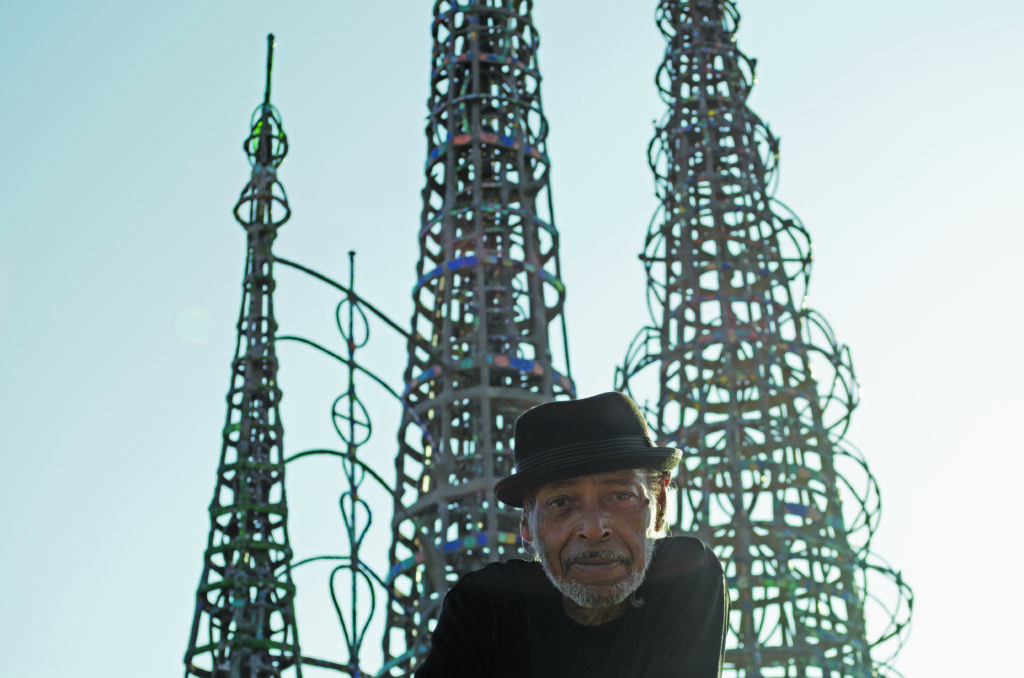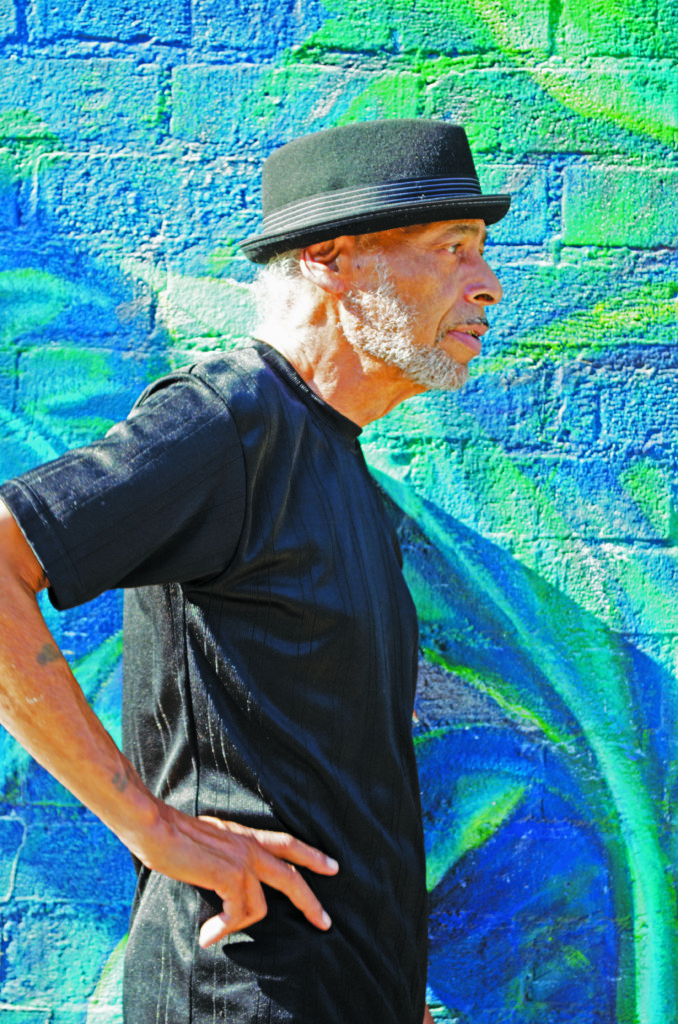
There used to be a lot more trees on this stretch of 103rd Street, but most of them were cut down so police helicopters could watch Watts’ residents from the sky. Amde Hamilton, 78 years old, still moves down these streets that he grew up on with a glide you can imagine him having in the late ‘60s, when he formed the Watts Prophets with Otis O’Solomon and Richard Dedeaux.
Formed out of the fury of the Watts Riots in 1965, the Watts Prophets were young black poet-performers railing against police brutality, institutionalized poverty, American hypocrisy, complacency and the possibility of revolution; they went so hard that they often shouted over each other during performances.
Accompanied with percussion, and later by pianist Dee-Dee McNeil, the Watts Prophets style of performing — between street talking and revolutionary sermon — laid the stylistic foundation for West Coast hip-hop. On 1997’s “I Remember Watts,” Dedeaux, who once challenged Muhammad Ali to a poetry fight (spoiler: Ali lost), recalled the town as a kid: “warm days of running around with no shoes and socks/but lots and lots of cops!”
The neighborhood has changed a little since Hamilton and Dedeaux were kids. It’s now a majority Latinx community, much like a good portion of South L.A. But many of the same problems still persist. Hamilton is still as invested in seeing the community flourish as ever. He is the kind of guy who says hello and honestly cares to hear how everyone he passes by is doing; high school kids walking home, old timers reminiscing on a porch, abuelitas waiting at bus stops.
Hamilton has started a new Watts Writers Workshop for kids in the community, so they can tell their own stories through the arts. He is still writing the direct, socially attuned poetry that he wrote with the Watts Prophets years ago.
We talked while Hamilton drove around Watts, and in his small apartment in Leimert Park, where his albums, African and Caribbean art and pictures of him when he was an ordained priest in the Ethiopian Orthodox Church are scattered around the living room. The conversation considered his life, his poetry, and how South L.A. is and always has been changing.
What are your earliest memories of Watts?
There was music on Central Avenue on both sides….from downtown around Fifth Street, all the way into Watts, and into Compton. But it stopped right there in Watts. African Americans couldn’t live across Alameda going east. And that was our community. Integration is the disintegration of those being integrated. When we integrated everybody left and the community was not supported by the black mayor [Tom Bradley]. He was a wonderful guy for some people, but he wasn’t for us.
Where did those folks go?
They went west. The white flight, they came and took over those homes. The whites moved further west.
So South L.A. was being gentrified even back in the ‘60s?
There always was gentrification and social engineering here in Los Angeles. After the Watts Riots, social engineering became kind of like a cottage industry. That’s what’s going on now. We’re watching it. We’re watching gentrification. Nothing’s changed. South L.A. is like when Bob Marley talks about Trench Town. It’s only a microcosm of what’s happening in the rest of the world, and that’s the same thing the Watts Prophets were doing for our community. We weren’t addressing anybody but ourselves, but our message happened to have a universal ring to it.

How did the Watts Prophets start?
The Watts Prophets started at Budd Schulberg’s Watts Writers Workshop. He was a Hollywood [screenwriter and novelist] who came to Watts shortly after the riots — almost when the flames were still burning. His career was at a low, and he saw that one little building was left standing at 10950 Central, and so he went in there and asked what he could do. And all he could do was write, so he said he’d start a writing program. That was the beginning of Budd Schulberg’s writing workshop. I happened to come to the workshop in 1967, and that’s where I started my career as a poet. You don’t become a poet until your lines are living.
Is it true that you met DJ Quik and he recited some of your poetry to you?
That happened one time. I didn’t know anything about sampling, but people had been telling me they been hearing my poems. So one day a girl asked me if I’d go to a concert in Bakersfield with some rappers. It was Eazy-E, DJ Quik, and AMG, and several others. She brought me through the back gate, and left me in a corridor saying that she’d be right back. While I’m standing there, down the hall comes DJ Quik, Eazy-E, AMG and when they get to me, I don’t know them, but when they pass by me, DJ Quik stops and goes ‘Hey, hold on guys, do y’all know who that is?’ And they all go, ‘no man, we don’t know who that is. Who is it?’ He says, ‘That’s Amde of the Watts Prophets.’ And they all start doing one of my poems. Each one were doing a different one. It was the first time that I realized that young people were listening to my poetry. They had actually memorized it. It was like a beautiful rose just grew right in front of me. So you asked me how do I know? Well, it tends to come back at you.
Do you still write?
Of course. The Watts Prophets always write. We’ve never lost our point. We’ve been together 46 years, and we still do some of the same poetry from 46 years ago. We always had something new, and always added something, but we never changed our point. We want to keep pushing. Breed what you need. Talk up not down. We wasn’t going to stop saying that over and over. We had a constant in our poetry. We weren’t book sellers, we were truth tellers. And when you tell the truth, there’s consequences to that.
When the Watts Prophets started, how influenced were you by the local poetry scene like Jayne Cortez, and the jazz scene like Don Cherry or Ornette Coleman?
Those were the cats that encouraged us. And Ornette was my personal friend. A very close friend. Billy Higgins was a close friend. We were all raised in Watts together. And so they were the ones who first told us, ‘this is something hip that y’all doing. Just keep it up.’ Because nobody was listening to somebody behind a podium at some library, and the poets, African American poets, took it from the page to the stage. And that’s how this poetry movement that’s really eating the world, that’s where it really started.
“South L.A. is like when Bob Marley talks about Trench Town. It’s only a microcosm of what’s happening in the rest of the world, and that’s the same thing the Watts Prophets were doing for our community. We weren’t addressing anybody but ourselves, but our message happened to have a universal ring to it.”
Amde Hamilton
When you played shows, would they be at coffee houses or more traditional venues?
Everywhere. The Watts Prophets, the world was our stage. It’s still our stage. We didn’t have to get booked to do poetry. We were poets on the corner, in the bathroom, in the cafe, at the school, at the community center, with the winos at the back of the shop, with the people sitting on the corner, at the schools. That’s how we were able to spread our poetry: verbally. It was all done word of mouth really. When your lines live, as Shakespeare’s lived, people pronounce them all over the world like they do now. Evidently ours did. We never had a PR campaign. We never were published. We were just some poets from Watts who were doing our thing. Saying what we wanted to say to people. To me, all the great poets had one love, and that was the truth. But a universal truth, not just their truth.
What are your memories of the riots?
During the riots, I was in an insane asylum. So I wasn’t there. I didn’t get out until ‘66. I was a drug addict, and the insane asylum was in the federal pen. They had a program in Ft. Worth, Texas where they sent drug addicts.
That’s a full year after the riots. What did you notice had changed about the community?
The influx of carpetbaggers. There were millions of dollars that were coming after the riots through LBJ’s war on poverty. People came from everywhere to get that money. Poverty programs came up everywhere, the government was pouring money in. It was the first signs of social engineering that we could see because we watched our community and how they would change it.
How has it changed since then?
Oh, it’s completely changed man. There was a black community here. Now it’s kind of liquid. It’s not a solid African American community. Leimert Park is not the essence of black culture and tradition and history and art. Black culture is a whole community. It’s not just a couple of blocks. It’s a nice place to exhibit your art, but that’s not the complete picture of creativity of African Americans. That’s a portion of this community. That’s what it represents. It always has represented a lot of great artists. This is where Lester Young is from. Dexter Gordon. Eric Dolphy. Horace Tapscott.This is all their community. It’s always had a tradition of rearing great artists. Just the same in Watts. Usually they came from Watts and moved west. They came from Central Avenue. There were as many jazz musicians on Central Avenue as there were in New York, but they didn’t get the play, the P.R. But Central Avenue had jazz on both sides of the street when I was a boy. All you heard when you walked down was music. But I’ve never left. I just started the new Watts Writer’s Workshop at the W.L.C.A.C. [The Watts Labor Community Action Committee.] African American children out here are really being neglected. It’s like people don’t see us anymore. I work with everybody; it doesn’t make any difference, but I see the great need in the African American community. Thing is, I’ve never stopped working in Watts. Even when I was living in Humboldt because my wife was sick and I needed to be there for her, I never stopped coming down to do stuff here. I’ll be here until I can’t do no more.